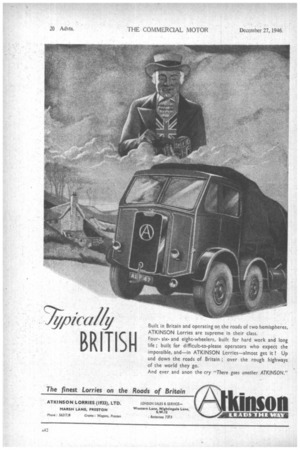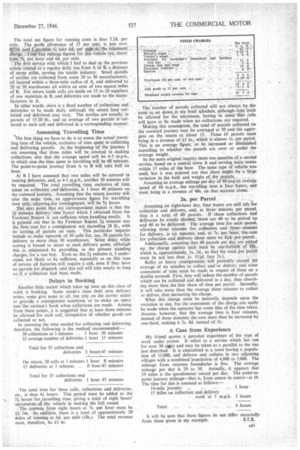BRITISH
Page 44

Page 45

If you've noticed an error in this article please click here to report it so we can fix it.
Built in Britain and operating on the roads of two hemispheres, ATKINSON Lorries are supreme in their class.
Foursixand eight-wheelers, built for hard work and long life ; built for difficult-to-please operators who expect the impossible, and—in ATKINSON Lorries—almost get it ! Up and down the roads of Britain ; over the rough highways of the world they go.
And ever and anon the cry "There goes another ATKINSON."
The total net figure for running costs is thus 5.2d. per mile. The profit allowance of 15 per cent, is just over (c'75d. and 1,,KopOSe to take 6d per niale..assthe. minimum dliaige. Time ind mileage figures for this vehicle are, there
fore. 7s, per hour and 6d. per mile. • The first service with which I had to deal in the previous article related to a regular daily run from A to B, a distance of seven miles, serving the textile industry. Small parcels of textiles are collected from some 20 to 30 manufacturers, all located within a three-mile radius of A, and delivered to 20 or 30 warehouses all within an area of two square miles of B. For return loads calls are made on 15 to 20 suppliers of raw materials in B, and deliveries are made to the manufacturers in A.
In other words, there is a fixed number of collections and deliveries to be made daily, although the actual load collected and delivered may vary. The textiles are usually in parcels of 15-20 lb.. and an average of two parcels is collected at each call and delivered in a corresponding manner.
Assessing Travelling Time
The first thing we have to do is to assess the actual travelling time of the vehicle, exclusive of time spent in collecting and delivering parcels. At the beginning 'of the journey I am assuming that three miles will be covered in making collections, also that the average speed will be 4-5 m.p.h., in which case the time spent in travelling will be 44) minutes. The point-to-point journey from A to B will take half an hour.
At B I have assumed that two miles will be covered in making deliveries; and, at 4-5 m.p.h., another 30 minutes will be required. The total travelling time, exclusive of time taken on collection and deliveries, is I hour 40 ,minutes on the outward journey. Assuming that the return journey will take the same time, an approximate figure for travelling time only,-"allowing for contingencies, will be 311 hours.
The next point that my correspondent makes is that the
min/4s delivery time factor which I obtained from the Fawkner:Report is not sufficient when handling smalls. It is pointed out that in the Fawkner Report 2i minutes was the time'cost for a consignment not exceeding 28 lb., with no sorting of parcels on vans. This particular inquirer ihtends to make upwards of 30 calls for, say,,50 parcels for delivery to more than 30 warehouses. Some delay while sorting is bound to occur at each delivery point, althcrugh this is. minimized by providing, in the present standing charges, for a van boy. Even so, the 2/ minutes is, I understand, not likely to be sufficient, especially as on this type of service all factories, will require a call, even if they have no parcels for dispatch, and this call will take nearly as long as, if a collection had been made.
Delays 'in Booking
Another little matter which takes up time on this class of' work is booking. Some senders issue their own delivery notes; some give none at all, but rely on the carrier either to provide a consignment notebook or to make an entry into the carman's book when collections are made. Arising from these points, it is suggested that at least three minutes be allowed for each call, irrespective Of whether goods are collected or not.
In assessing the time needed for collecting and delivering, therefore, the following is the method recommended:30 collections at 3 minutes ... 1 hour 30 minutes 25 average number of deliveries 1 hour 15 minutes Total for 55 collections and
deliveries 2 hours 45 minutes
On return, 20 calls at 3 minutes I hour 0 minutes 15 deliveries at 3 minutes ... 0 hour 45 minutes Total for 35 collections and deliveries 1 hour 45 minutes
The total time for these calls, collections and deliveries, etc.. is thus 41 hours. This period must be added to the 3i hours for travelling time, giving a total of eight hours' occupation of the vehicle in making the full round. The revenue from eight hours at 7s. per hour must be 4-16s. Inaddition, there is a total of approximately 20 miles of running at 6d. per mile (10s.). The total revenue must, therefore, be £3 6s. The -number of parcels collected will not always be the same as set down in my brief schedule, although time -mist be allowed for the maximum, having in mind 'dial calls will have to be made when no collections are required. • Making this assumption, the total of parcels collected on the outward journey' maybe averaged at 50 and the aggregate on the return at about 15. These 65 parcels must bring in a revenue of £3 6s., which is almost Is. per parcel. This is an average figure, t6 be increased or diminished according to whether the parcels are over or under the
average weight. In the same original inquiry there was mention of a second service, based on a central town A and serving main towns within 15 miles of the base. The same type of vehiele Was used, but it was pointed out that there might be a large variation in the bulk and weight of the parcels.
Assuming an average mileage per day of 40 and an average speed of 10 m.p.h., the travelling time is four hours, and must bring in a revenue of 48s. on that account alone.
2s. per Parcel Assuming an eight-hour day, four hours are still left for collection and delivery, and, at three minutes per parcel, that is a total of 80 parcels. If these collections and deliveries be evenly divided, there are 40 to be picked up and 40 to be delivered.The average time for each parcel, allowing three' minutes for collection and three minines for delivery, is six minutes, and, at 7$. 'per hour, rtbe,cost for collection and, delivery atone must be Sid. per parcel.
Additionally, assuming that 40 parcels per day are picked up, the charge against each Must be one-fortieth of 45s... which is, approximately, Is. 3d., so that the total per paicel must be not less than Is. 11-id. (say 2s.).
Bulky or heavy consignments will probably exceed the average of six mintites to collect and/or deliver, and some assessment of time mast be made in respect of these on a double account First, they will reduce the number of parcels which can be collected and delivered in a day, thus absorbing more than the fair share of time per parcel. Secondly, it will take more than the average three minutes to collect or deliver, thus increasing the charge.
What this charge must be naturally depends upon the variation in size, but the assessment of the charge can easily be made when the operator has some idea of the time taken.. Assume, however, that the average time is four minutes, instead of three minutes; the cost must then be increaSed by one-third, making it 2s. 8d. instead of 2s.
A Case from Experience
My friend quotes a personal experience of the type of work under review. It refers to a service which has run for over 30 min and may be taken as a parallel to the one just described. It is centralized in a town having a population of 15,000, and delivers and collects in two adjoining villages with a combined 'population of 4,000 to 5,000. The mileage from extreme boundaries is five. The average mileage per day is 29 to 30. Actually, it appears that 29 miles is the speedometer record per day. The point-topoint journey mileage—that is, from centre to centre—is 14. The time for this is assessed as follows: 14-mile journey ... 1 hour 15 miles' on Collection and delivery Total ... 4 hours work at 5 m.p.h. 3 hours




































































